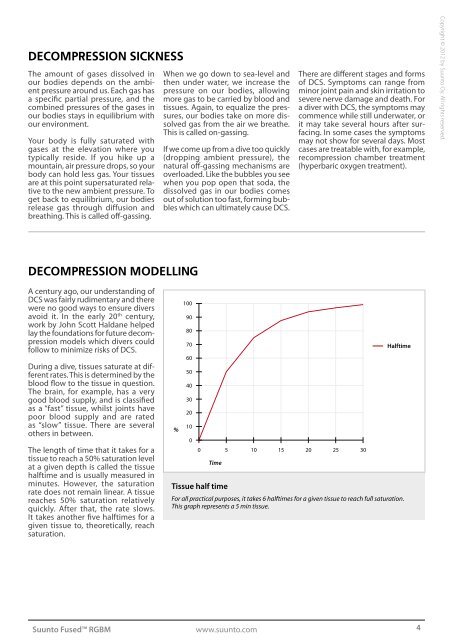Suunto Fused™ RGBM
Suunto Fused™ RGBM
Suunto Fused™ RGBM
- No tags were found...
Create successful ePaper yourself
Turn your PDF publications into a flip-book with our unique Google optimized e-Paper software.
DECOMPRESSION SICKNESSThe amount of gases dissolved inour bodies depends on the ambientpressure around us. Each gas hasa specific partial pressure, and thecombined pressures of the gases inour bodies stays in equilibrium withour environment.Your body is fully saturated withgases at the elevation where youtypically reside. If you hike up amountain, air pressure drops, so yourbody can hold less gas. Your tissuesare at this point supersaturated relativeto the new ambient pressure. Toget back to equilibrium, our bodiesrelease gas through diffusion andbreathing. This is called off-gassing.When we go down to sea-level andthen under water, we increase thepressure on our bodies, allowingmore gas to be carried by blood andtissues. Again, to equalize the pressures,our bodies take on more dissolvedgas from the air we breathe.This is called on-gassing.If we come up from a dive too quickly(dropping ambient pressure), thenatural off-gassing mechanisms areoverloaded. Like the bubbles you seewhen you pop open that soda, thedissolved gas in our bodies comesout of solution too fast, forming bubbleswhich can ultimately cause DCS.There are different stages and formsof DCS. Symptoms can range fromminor joint pain and skin irritation tosevere nerve damage and death. Fora diver with DCS, the symptoms maycommence while still underwater, orit may take several hours after surfacing.In some cases the symptomsmay not show for several days. Mostcases are treatable with, for example,recompression chamber treatment(hyperbaric oxygen treatment).Copyright © 2012 by <strong>Suunto</strong> Oy. All rights reserved.DECOMPRESSION MODELLINGA century ago, our understanding ofDCS was fairly rudimentary and therewere no good ways to ensure diversavoid it. In the early 20 th century,work by John Scott Haldane helpedlay the foundations for future decompressionmodels which divers couldfollow to minimize risks of DCS.During a dive, tissues saturate at differentrates. This is determined by theblood flow to the tissue in question.The brain, for example, has a verygood blood supply, and is classifiedas a “fast” tissue, whilst joints havepoor blood supply and are ratedas “slow” tissue. There are severalothers in between.The length of time that it takes for atissue to reach a 50% saturation levelat a given depth is called the tissuehalftime and is usually measured inminutes. However, the saturationrate does not remain linear. A tissuereaches 50% saturation relativelyquickly. After that, the rate slows.It takes another five halftimes for agiven tissue to, theoretically, reachsaturation.%10090807060504030201000Time5 10 15 20 25 30HalftimeTissue half timeFor all practical purposes, it takes 6 halftimes for a given tissue to reach full saturation.This graph represents a 5 min tissue.<strong>Suunto</strong> Fused <strong>RGBM</strong> www.suunto.com 4
















